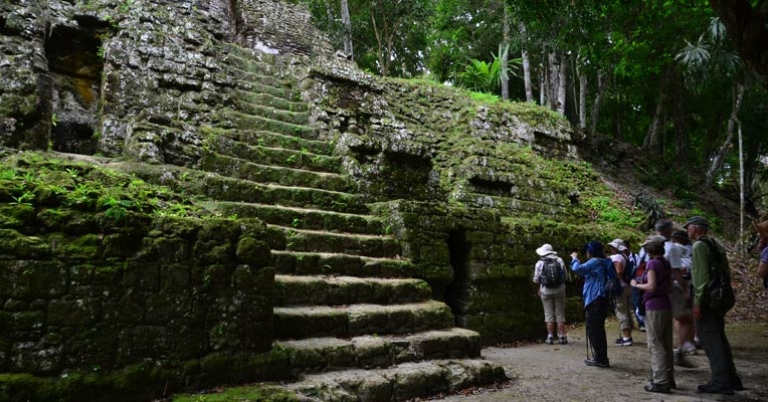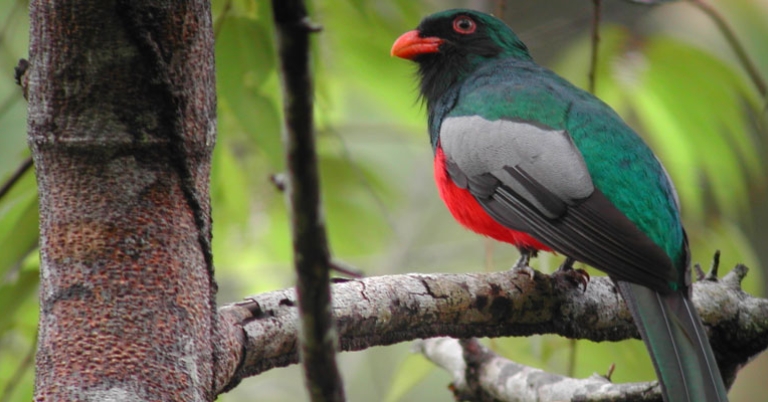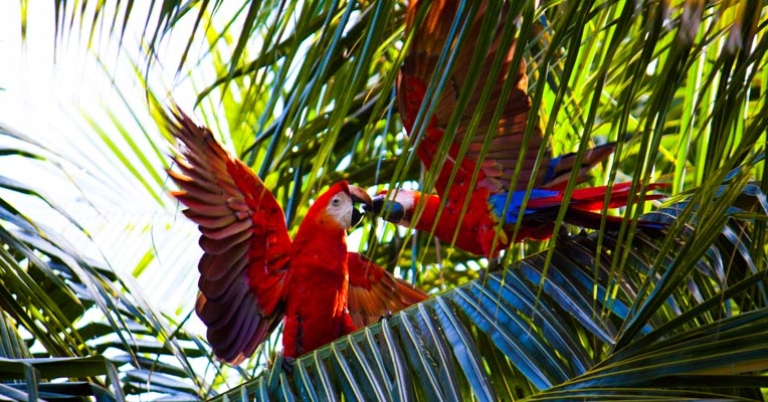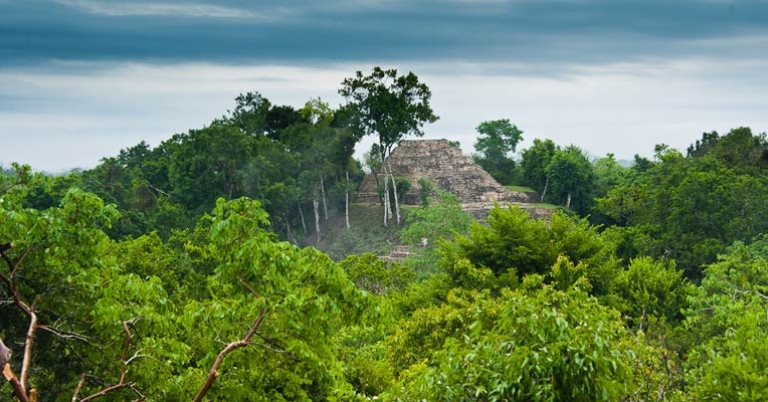Belize and Guatemala | Neotropical Birds and Mayan Ruins
Date:
Activity Level:
Duration:
Price:
Interests:
About this trip
 In what are now the countries of Belize and Guatemala, the ancient Maya civilization once flourished, leaving behind cities, temples, pyramids, and observatories still standing, enshrouded in tree cover. Amid rainforests and valleys, archaeological sites tell the story of this culturally rich region while also providing habitat for a diversity of flora and fauna, including hundreds of bird species. Join Clearwater Audubon Society on this 9-day journey to seek out resident and migratory avifauna across a variety of ecosystems. Along the way, you’ll also learn about bird-based tourism initiatives and conservation efforts from local community-based organizations.
In what are now the countries of Belize and Guatemala, the ancient Maya civilization once flourished, leaving behind cities, temples, pyramids, and observatories still standing, enshrouded in tree cover. Amid rainforests and valleys, archaeological sites tell the story of this culturally rich region while also providing habitat for a diversity of flora and fauna, including hundreds of bird species. Join Clearwater Audubon Society on this 9-day journey to seek out resident and migratory avifauna across a variety of ecosystems. Along the way, you’ll also learn about bird-based tourism initiatives and conservation efforts from local community-based organizations.
Highlights
- Discover both concentrated flocks and rare sightings of avifauna, such as the Jabiru, Yellow-headed Parrot, Yucatan Jay, and Yucatan Woodpecker, in the wetlands and pine savannas of Crooked Tree Wildlife Sanctuary.
- Examine Maya history at the Tikal and Yaxhá archaeological sites, and go birding amid the ancient structures and surrounding forests.
- Meet with members of the Petén Birding Association, a local group dedicated to birding, environmental education, and conservation through ecotourism.
- Hike the trails at Cockscomb Basin Wildlife Refuge, a tropical moist forest sheltering some 300 avian species, including trogons, tanagers, flycatchers, and the Yellow-billed Cacique.
- Learn about a community-based conservation project in the village of Red Bank aimed at saving and creating habitat for the Scarlet Macaw.
- Enjoy up-close encounters with some of the country’s native fauna, including a pair of Harpy Eagles, at the Belize Zoo.
Meet your leader
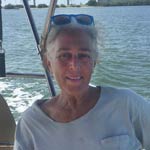 Madeleine Bohrer
Madeleine Bohrer
Madeleine Bohrer has been with Clearwater Audubon for more than 25 wonderful birding years. She has had the honor and pleasure to take groups on international birding adventures to Ecuador, Trinidad and Tobago, and Panama. Birding outside the U.S. is an experience that changed her life. She is excited to share this unique Belize & Guatemala trip with fellow birders.
Activity Level 3: Moderate
Participants should be able to ascend or descend 60 stairs consecutively, plus walk for at least 3 hours over some steep slopes, uneven, and potentially slippery surfaces without difficulty. Physical activities typically last for 3 or more hours at a time.
$3,995
Per person
About this price
Land cost only. Does not include round-trip airfare to and from destination.
Single room supplement $675
What makes us different
Wildlife up-close
Top birding guides
Scopes
Cultural Discovery
Flight arrangements
Service anytime
Daily Itinerary
Print ItineraryArrival, Belize City
Crooked Tree
Crooked Tree
Belmopan
El Remate
El Remate
Mayflower National Park
Mayflower National Park
Farewell!
Pricing
Print Pricing$3,995
Per person
About this price
Land cost only. Does not include round-trip airfare to and from destination.
Single room supplement $675
What's Included
- Activities and meals as mentioned in itinerary
- Arrival transfers are provided on individual flight basis
- Departure transfers are provided on group basis
- Full time expert birding naturalist guide for duration of program
- Internal flights relevant to itinerary
- Non alcoholic beverage with meals
- Private transportation and driver for the duration of the program
What's Not Included
- Carbon Offset
- International airfare
- Items of personal nature
- Tips
- Travel Insurance
Pricing Details
A deposit of $350 is required for participants to register and reserve space on the program. Reservations submitted beyond the final payment deadline noted below will require full payment to enroll. 120 or more days before departure: $100 cancellation fee; remaining balance is refunded. 119 - 96 before departure: full deposits of $350 is forfeited. 95 - 0 days before departure: 100% of program price is forfeited.
Holbrook Travel strongly recommends the purchase of travel protection for medical emergencies while traveling and to protect your investment. Please note the purchase of Cancel for Any Reason Coverage or to exclude pre-existing conditions with Trip Cancellation coverage may require policy purchase within 10-14 days of your initial deposit, depending upon the provider.
Single room supplement $675
Final payment due date: November 09, 2025
Travel Info
Print Travel InfoEntry & Exit Requirements
U.S. citizens must have a valid passport to enter Belize and Guatemala. Passports must be valid for at least six months after the date of entry. A visa is not required for visits up to 30 days in Belize and up to 90 days in Guatemala.
If you are traveling with minors, you may be asked to show U.S. birth certificates for each child. You may also be required to present documentation that the minor is traveling with the permission of any non-traveling parents/guardians, such as with a notarized letter of consent, custody decree, adoption papers, or death certificates.
If you are not traveling with a U.S. passport, please check with the Belizean and Guatemalan Embassies for the requirements based on your nationality.
When leaving Belize by air, there is a departure tax of USD $55.50, which is usually included in the cost of your airfare. Consult with your airline to determine whether the departure tax is included in your ticket cost. If the departure tax is not included in your ticket cost, it should be paid at the airport prior to check-in, payable in cash only (U.S. currency). When crossing the land border into Guatemala, please be prepared to pay the exit fee of USD $20 for U.S. citizens, payable in cash only (U.S. currency). Please note exit taxes are subject to change without prior notice.
Health Information
IMMUNIZATIONS
The Centers for Disease Control recommends that all travelers be up to date on routine vaccinations such as measles-mumps-rubella (MMR) vaccine, diphtheria-pertussis-tetanus vaccine, varicella (chicken pox) vaccine, and your yearly flu shot before every trip.
There are no vaccinations required for entry into Belize or Guatemala, unless you are traveling from (or transiting through) a country where yellow fever transmission is a risk, in which case proof of yellow fever vaccination is required.
The CDC recommends vaccination against hepatitis A, hepatitis B, and typhoid for most unvaccinated travelers visiting Belize and Guatemala.
Please consult your physician for additional information and recommendations based on your individual circumstances.
MALARIA
Malaria is caused by a parasite found in Anopheles mosquitos, which are active from dusk until dawn. The CDC advises that travelers to the Petén department of Guatemala (where Tikal is located) may be at risk for malaria and should take precautions against mosquito bites.
To protect against mosquitos, the CDC recommends that you cover exposed skin with lightweight, long-sleeved shirts and pants, consider treating clothes with permethrin, and use an insect repellent containing an EPA-registered active ingredient like DEET, picaridin, or oil of lemon eucalyptus (OLE). Apply sunscreen first, followed by the repellent, ideally 20 minutes later.
Be careful when applying products containing DEET, as it can damage or dissolve certain synthetic fabrics as well as plastic, rubber, vinyl, or elastic materials, such as those used in camera equipment, binoculars, phone cases, sunglasses, or watches. Additionally, some research suggests that when DEET and picaridin enter local waterways, they can be harmful to amphibians and other wildlife. When selecting a repellent, it is ultimately up to each traveler to weigh the risks and benefits of different options, keeping in mind both environmental factors and the importance of protecting against illness.
Consult your physician to determine whether antimalarial medication is recommended.
DENGUE FEVER AND OTHER MOSQUITO-BORNE ILLNESSES
Locally transmitted cases of dengue fever have been reported in Belize and Guatemala. Local transmission means that mosquitoes in the area have been infected with dengue and are spreading it to people. Additionally, locally transmitted cases of Zika virus, leishmaniasis, and other insect-borne illnesses have previously been reported in Belize and Guatemala. As there are no vaccinations to protect against these illnesses, the CDC recommends travelers protect themselves against insect bites using the measures noted above.
As a precaution, the CDC advises women who are pregnant to consider postponing travel to any area where Zika virus transmission is ongoing.
After spending time outdoors, especially in grassy or wooded areas, the CDC recommends showering and conducting a fullbody check for ticks. If you find a tick attached to your skin, safely remove it as soon as possible.
SUN EXPOSURE
The effects of the sun can be damaging to the eyes and skin. Spending time outdoors exposes you to the sun’s harmful ultraviolet (UV) rays, even on cloudy days. To protect yourself from the sun, use a broad spectrum sunscreen of at least SPF 15, protect skin with clothing, wear a wide-brimmed hat and sunglasses, and drink plenty of fluids.
Respiratory Illness Protocols
Please review our Respiratory Illness Protocols page, which explains our policy and procedures if you or another traveler should develop symptoms of a respiratory illness during your trip. Your participation in a Holbrook Travel program indicates that you are in agreement with these protocols.
Resources
Print ResourcesPacking Recommendations
Everyone has personal preferences when it comes to packing; for this reason, the information below is offered as a general guide and not a definitive list. You know yourself best: Use your discretion and pack what you think will serve you, based on your personal preferences and specific itinerary.
You may find many of the items below in our Gear Store.
CLOTHING
Casual, comfortable clothing is suitable for most activities in Belize and Guatemala. You may wish to bring a slightly nicer outfit or two (eg sundress, polo shirt) if your itinerary includes dinners out or more formal activities.
Bring enough clothing suitable for the length of your program. If you prefer to pack light, note that many hotels offer laundry services at additional cost. If you plan to hand-wash items, remember that humidity may delay drying time.
Pack clothing that can be worn in layers to adapt to weather changes throughout the day. The region’s rainy season is June to November, but it can rain at any time. Clothing that wicks away moisture and dries quickly is recommended.
- A combination of short-sleeved and lightweight, long-sleeved shirts for sun and mosquito protection
- Shorts
- Lightweight, quick-drying long pants for sun and mosquito protection
- Undergarments
- Sleepwear
- Lightweight jacket or sweater/sweatshirt
- 1-2 bathing suit(s) for the beach, if applicable, plus many hotels have pools
- Socks – Bring extra pairs. If your itinerary indicates muddy hikes with rubber boots provided on-site, pack a few pairs of knee socks to prevent blisters.
- Shoes – Consider your specific itinerary when choosing footwear. For most programs, you’ll likely want at least one pair of comfortable, closed-toe walking or hiking shoes suitable for forest hikes and walking over cobblestones or other uneven terrain. Sturdier hiking boots may be appropriate for more active itineraries. In addition, many participants opt for a pair of sturdy sport-strap sandals (e.g. Keens, Tevas, or similar) and/or casual flip-flops or sandals. If you’re caving or visiting the beach or cayes, you may also want a pair of aqua socks, reef walkers, or water shoes.
- Lightweight rain jacket, hooded poncho, and/or windbreaker
- Visor or wide-brimmed sun hat
- Bandana, scarf, or neck gaiter
Personal Toiletries
Pack toiletries based on your personal preferences and habits. Below are just a few recommendations to keep in mind.
- Shampoo, conditioner, lotion, deodorant/antiperspirant , etc. – If possible, avoid strong fragrances if you are sensitive to insect bites and to be considerate of your fellow travelers.
- Soap and washcloth or a small, quick-drying microfiber towel – Washcloths are not standard in all hotels. If you normally use a washcloth, you may wish to bring one from home.
- Hairbrush, comb, hair ties, shower cap. Most—but not all—hotel rooms provide a hair dryer, but you may wish to bring one from home.
- Toothbrush and toothpaste
- Razor
- Ear plugs, especially if you are a light sleeper
- Personal hygiene products
- Insect repellent with DEET or picaridin (see note below about treating clothing with permethrin)
- Sunscreen and lip balm with SPF – If you’ll be in the ocean, we strongly recommend reef-safe sunscreen.
- Aloe vera gel
- A travel pack of tissues – also useful as napkins or toilet paper if needed
In addition to your personal toiletries, it is useful to pack a small medical kit, which you can easily prepare. Helpful items might include: bandages, antihistamine, a pain reliever, motion sickness and/or altitude sickness medication (if you are prone to either), anti-diarrhea medicine, individually wrapped pre-moistened towelettes and/or hand sanitizer, antibiotic ointment, anti-fungal cream, moleskin for blisters, eye drops, tweezers, a mini sewing kit, and an extra pair of disposable contact lenses or eyeglasses if you wear them.
Days before you leave home, you may wish to consider spraying any clothing, socks, and shoes that will be worn in lowland, tropical sites with permethrin, an anti-parasite medication, to repel irritating pests and prevent the spread of disease. A recommended brand is Sawyer. Carefully read all instructions before use. Please note permethrin is highly toxic to cats and fish, and some aerosol products may be harmful to birds. Side effects may include minor itching, burning, or redness. You may want to use a laundry marker to label and keep track of which socks are permethrinized. Only one application per item is necessary; permethrin on treated clothes remains effective through several washings. Permethrin should NOT be applied directly to skin.
Miscellaneous
Remember to pack valuables such as your passport, cash/credit cards, and medications in your carry-on luggage.
- Passport and photocopies of all travel documentation
- Personal insurance card and travel insurance information
- Money – ATM/credit card, traveler's checks, and/or cash; small bills in good condition are recommended
- Prescription medicines (if applicable), with a copy of the prescription
- Yellow fever certificate (if required; only if arriving from a country where yellow fever transmission is a risk)
- Sunglasses with strap
- Small day pack for hikes and excursions
- Flashlight and/or head lamp
- Travel alarm clock or inexpensive waterproof wristwatch with alarm – Not all hotels provide alarm clocks.
- A pocket calculator or phone to assist with conversions and currency exchange
- Binoculars with lens cleaner
- Camera and related equipment, such as charger, lenses, and extra memory cards
- Reusable water bottle
- Non-perishable snacks
- Pocket-knife or multipurpose tool - Pack in your checked luggage
- Zip-top style bags – useful for packing toiletries, sorting clothing, storing damp or muddy shoes, or as a dry bag for protecting electronics
- Notepad or travel journal and pen
- Music or reading material for down time, long bus drives, or on the airplane, and a portable bright light to read by
- Collapsible walking stick with rubber tip
- A small quantity of laundry detergent if you’ll be washing clothing by hand
- Travel-size umbrella – Some people find this unwieldy to carry, while others find it offers better protection than a rain jacket alone.
- Money belt
- Converter/adapter
- Chargers for electronics

Questions
Contact Jill Hays at 877-846-6296 or jill@holbrooktravel.com.

